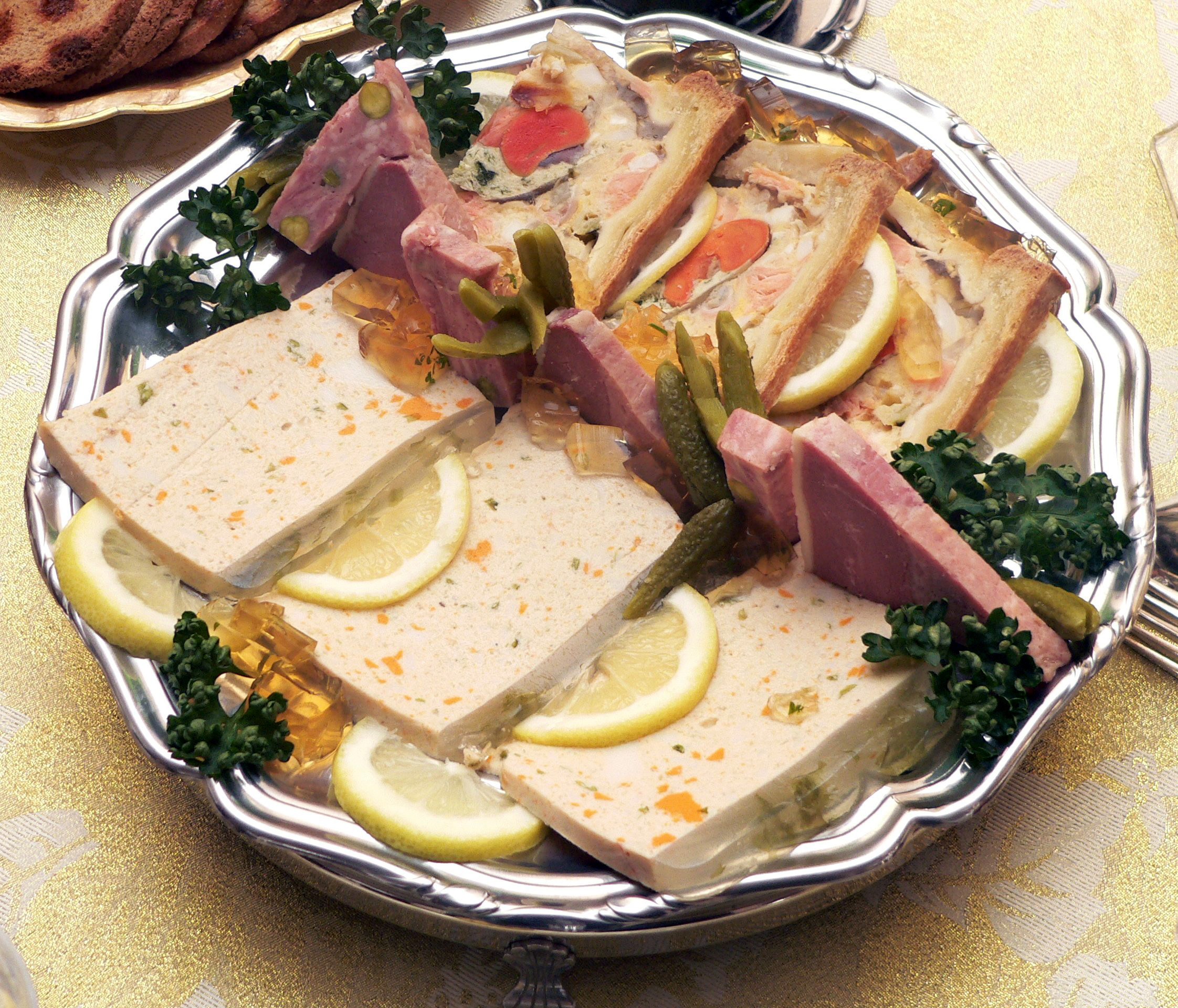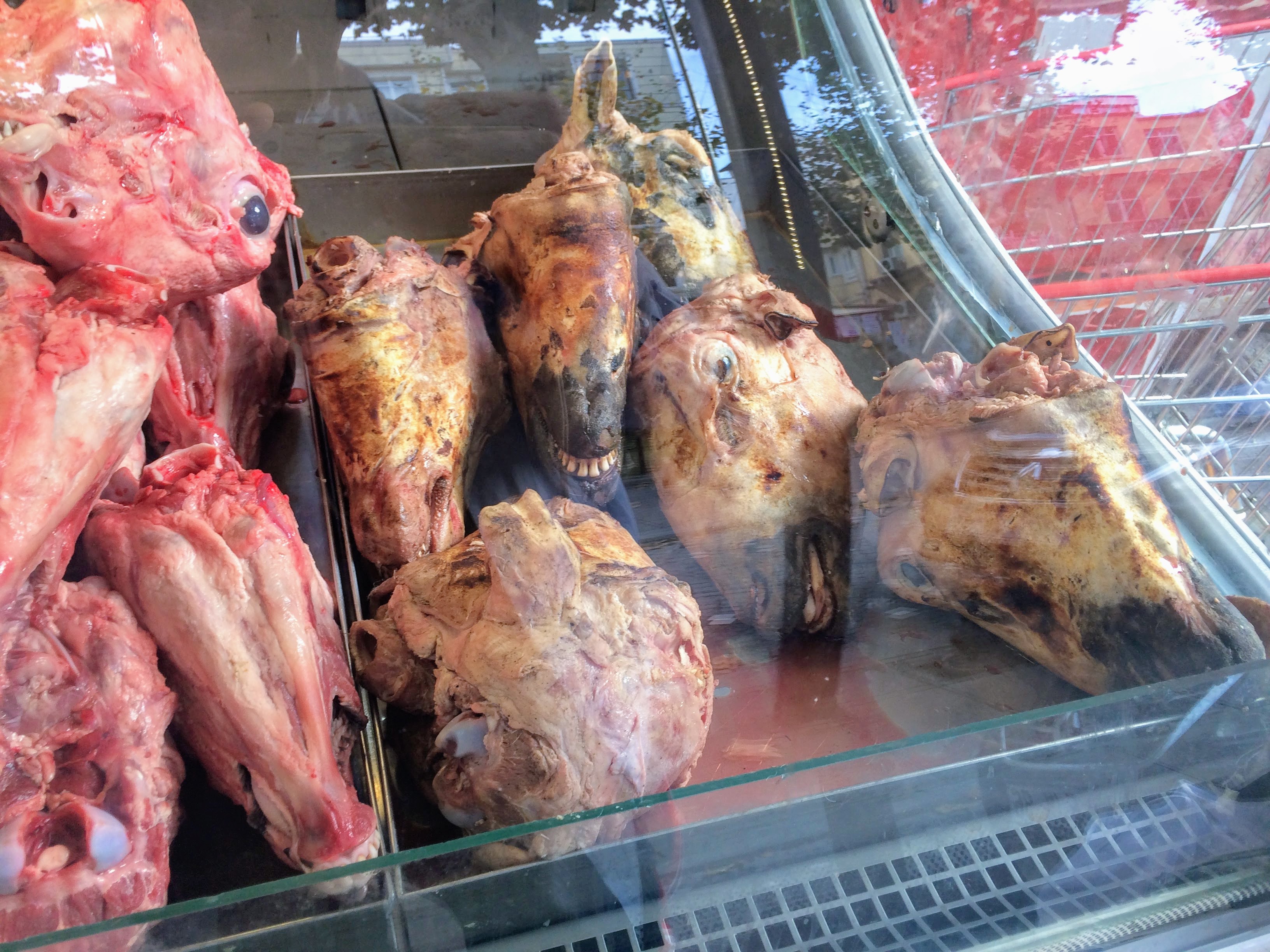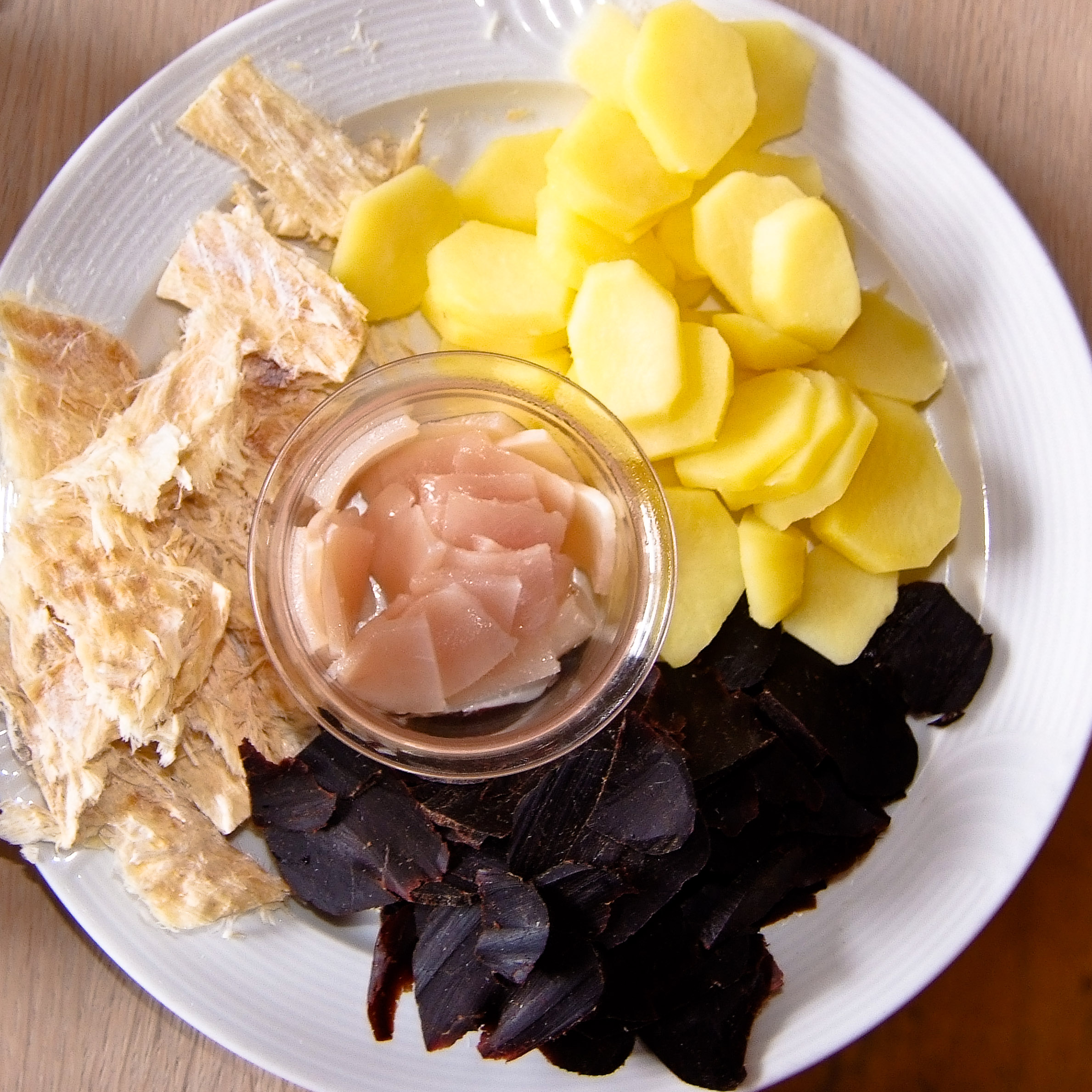|
Svið
Svið (; transliterated as svid or svith) is a traditional Icelandic dish consisting of a sheep's head cut in half, singed to remove the fur, and boiled with the brain removed, sometimes cured in lactic acid. Svið originally arose at a time when people could not afford to let any part of a slaughtered animal go to waste. It is part of þorramatur, a selection of various traditional Icelandic food that is served as a buffet, particularly at the Þorrablót mid-winter festival. It is used as the basis for sviðasulta (head cheese or brawn, made from bits of svið pressed into gelatinous loaves pickled in whey). Similar dishes can also be found in other Western Nordic countries, such as smalahove in Norway and seyðarhøvd on the Faroe Islands. When eating svið, the ears are sometimes considered taboo due to the superstitious belief that when they (bearing the mark of the animal's owner) are removed, the eater will be accused of theft. It is sometimes held that if the littl ... [...More Info...] [...Related Items...] OR: [Wikipedia] [Google] [Baidu] |
þorramatur
Þorramatur (; transliterated as thorramatur; ) is a selection of traditional Icelandic food, consisting mainly of meat and fish products cured in a traditional manner, cut into slices or pieces and served with rúgbrauð (dense and dark rye bread), butter and brennivín (an Icelandic akvavit). Þorramatur is consumed during the Nordic month of ''Þorri'' (Thorri), in January and February, particularly at the mid-winter feast of Þorrablót (Thorrablot) as a tribute to old culture. Being thus connected with the tradition of Þorrablót festivals, Þorramatur is most often served as a buffet. History Þorramatur is an example of an invented tradition that first emerged with the midwinter festivals of regional associations of migrants who had moved from the Icelandic countryside to Reykjavík during the urbanisation boom of the post-World War II era. These festivals were very popular in the 1950s and 1960s and some of them are still held every year, although their impact on ... [...More Info...] [...Related Items...] OR: [Wikipedia] [Google] [Baidu] |
Offal
Offal (), also called variety meats, pluck or organ meats, is the internal organ (anatomy), organs of a butchered animal. Offal may also refer to the by-products of Milling (grinding), milled grains, such as corn or wheat. Some cultures strongly consider offal consumption to be taboo, while others use it as part of their everyday food, such as lunch meats, or, in many instances, as Delicacy, delicacies. Certain offal dishes—including ''foie gras'' and ''pâté''—are often regarded as gourmet food in the culinary arts. Others remain part of traditional regional cuisine and are consumed especially during holidays; some examples are sweetbread, Jewish chopped liver, Scottish haggis, U.S. chitterlings, and Mexican Menudo (soup), menudo. On the other hand, intestines are traditionally used as casing for sausages. Depending on the context, ''offal'' may refer only to those parts of an animal carcass discarded after butchering or skinning; offal not used directly for human or anim ... [...More Info...] [...Related Items...] OR: [Wikipedia] [Google] [Baidu] |
List Of Lamb Dishes
This is a list of the popular lamb and mutton dishes and foods worldwide. Lamb and mutton are terms for the meat of domestic sheep (species ''Ovis aries'') at different ages. A sheep in its first year is called a lamb, and its meat is also called lamb. The meat of a juvenile sheep older than one year is hogget; outside North America this is also a term for the living animal. The meat of an adult sheep is mutton, a term only used for the meat, not the living animal. Meat from sheep features prominently in several cuisines of the Mediterranean cuisine, Mediterranean. Lamb and mutton are very popular in Central Asian Cuisine, Central Asia and in Indian cuisine, India, where other red meats may be eschewed for religious or economic reasons. It is also very popular in Cuisine of Australia, Australia. Barbecued mutton is also a specialty in some areas of the United States of America, United States (chiefly Owensboro, Kentucky) and Canada. Lamb dishes * Abbacchio – Italy * ... [...More Info...] [...Related Items...] OR: [Wikipedia] [Google] [Baidu] |
Powsowdie
Powsowdie is a Scottish sheep's-head broth or soup. Traditional preparation of the soup includes sheep's trotters as an ingredient. Dried peas and barley can also be used as additional ingredients. Powsowdie has been described as a speciality dish in Edinburgh, Scotland. Powsowdie is less popular and less known in contemporary times; it was more prominent during times when "all parts of an animal were used in cooking and nothing was wasted". The National Library of Scotland included powsowdie in a 2015 food history exhibition named "Lifting the lid", which was an exhibit of historic Scottish recipe books that included example dishes. Etymology "Powsowdie" has also been used as a term for "milk and meal boiled together" and as "any mixture of incongruous sorts of foods." See also * List of soups * List of lamb dishes * Scottish cuisine Scottish cuisine (; ) encompasses the cooking styles, traditions and recipes associated with Scotland. It has distinctive attributes and ... [...More Info...] [...Related Items...] OR: [Wikipedia] [Google] [Baidu] |
Smalahove
''Smalahove'' (also called ''smalehovud'', ''sau(d)ehau(d)'' or ''skjelte'') is a Western Norwegian traditional dish made from a sheep's head, originally eaten before Christmas. The name of the dish comes from the combination of the Norwegian words ''hove'' and ''smale''. ''Hove'' is a dialectal form of ''hovud'', meaning "head" (''cf.'' Hǫfuð), and ''smale'' is a word for sheep, so ''smalahove'' literally means "sheep head". The skin and fleece of the head are torched, the brain removed, and the head is salted, sometimes smoked, and dried. The head is boiled or steamed for about three hours, and served with mashed swede/rutabaga and potatoes. It is also traditionally served with akevitt. In some preparations, the brain is cooked inside the skull and then eaten with a spoon or fried. Originally, ''smalahove'' was typically eaten by the poor. Traditional consumption One serving usually consists of one half of a head. The ear and eye are normally eaten first, as they are the ... [...More Info...] [...Related Items...] OR: [Wikipedia] [Google] [Baidu] |
Head Cheese
Head cheese () or brawn is a meat jelly or terrine made of meat. Somewhat similar to a jellied meatloaf, it is made with flesh from the head of a calf or pig (less commonly a sheep or cow), typically set in aspic. It is usually eaten cold, at room temperature, or in a sandwich. Despite its name, the dish is not a cheese and contains no dairy products. The parts of the head used vary, and may include the tongue but do not commonly include the brain, eyes or ears. Trimmings from more commonly eaten cuts of pork and veal are often used, and sometimes the feet and heart, with gelatin added as a binder. Variations of head cheese exist throughout Europe and elsewhere, with differences in preparation and ingredients. A version pickled with vinegar is known as ''souse''. Historically, meat jellies were made of the head of an animal, less its organs, which would be simmered to produce a naturally gelatinous stock that would congeal as the dish cooled. Meat jellies made this way we ... [...More Info...] [...Related Items...] OR: [Wikipedia] [Google] [Baidu] |
Kale Pache
Khash () is a traditional dish made from a boiled cow or sheep parts, which might include the head, feet, and stomach (tripe). It originates from Armenia and is considered one of the oldest Armenian dishes. In addition to Armenia, khash and its variations are also found in several other countries, including Afghanistan, Albania, Azerbaijan, Bosnia and Herzegovina, Bulgaria, Georgia, Greece, Iran, Iraq, Mongolia, North Macedonia, Turkey, and some Persian Gulf countries. Etymology The name ''khash'' originates from the Armenian verb (), which means "to boil". The dish, initially called ''khashoy'' (), is mentioned by a number of medieval Armenian authors, including Grigor Magistros (11th century), Mkhitar Heratsi (12th century), and Yesayi Nchetsi (13th century). The Persian designation ''pacha'' stems from the term , literally meaning "trotter". The combination of a sheep's head and trotters is called , which literally means "head ndtrotter" in Persian. Khash is known ... [...More Info...] [...Related Items...] OR: [Wikipedia] [Google] [Baidu] |
Smalahove
''Smalahove'' (also called ''smalehovud'', ''sau(d)ehau(d)'' or ''skjelte'') is a Western Norwegian traditional dish made from a sheep's head, originally eaten before Christmas. The name of the dish comes from the combination of the Norwegian words ''hove'' and ''smale''. ''Hove'' is a dialectal form of ''hovud'', meaning "head" (''cf.'' Hǫfuð), and ''smale'' is a word for sheep, so ''smalahove'' literally means "sheep head". The skin and fleece of the head are torched, the brain removed, and the head is salted, sometimes smoked, and dried. The head is boiled or steamed for about three hours, and served with mashed swede/rutabaga and potatoes. It is also traditionally served with akevitt. In some preparations, the brain is cooked inside the skull and then eaten with a spoon or fried. Originally, ''smalahove'' was typically eaten by the poor. Traditional consumption One serving usually consists of one half of a head. The ear and eye are normally eaten first, as they are the ... [...More Info...] [...Related Items...] OR: [Wikipedia] [Google] [Baidu] |
Faroese Cuisine
Important parts of Faroese cuisine are lamb and also fish owing to proximity to the sea. Traditional foods from the Faroe Islands include skerpikjøt (a type of dried mutton), seafood, whale meat, blubber, garnatálg, Atlantic puffins, potatoes, and few fresh vegetables. Much of the taste of this traditional country food is determined by the food preservation methods used; brine, drying, and the maturing of meat and fish, called ''ræstkjøt'' and ''ræstur fiskur''. Animal products dominate Faroese cuisine. Popular taste has developed, however, to become closer to the European norm, and consumption of vegetables has greatly increased in recent decades while consumption of fish has diminished. Fresh and ''ræst'' lamb meat remains very popular while traditional meat products, such as various types of sausages, have lost much of their appeal with younger generations. Types of food Fish Fish dishes in the Faroe Islands are caught in the waters of the North Atlantic Ocean. ... [...More Info...] [...Related Items...] OR: [Wikipedia] [Google] [Baidu] |
Reykjavík Grapevine
Reykjavík is the capital and largest city in Iceland. It is located in southwestern Iceland on the southern shore of the Faxaflói Bay. With a latitude of 64°08′ N, the city is the world's northernmost capital of a sovereign state. Reykjavík has a population of around 139,000 as of 2025. The surrounding Capital Region has a population of around 249,000, constituting around 64% of the country's population. Reykjavík is believed to be the location of the first permanent settlement in Iceland, which, according to , was established by Ingólfur Arnarson in 874 AD. Until the 18th century, there was no urban development in the city location. The city was officially founded in 1786 as a trading town and grew steadily over the following decades, as it transformed into a regional and later national centre of commerce, population, and governmental activities. Reykjavík is the centre of Iceland's cultural, economic, and governmental activity, and is a popular tourist desti ... [...More Info...] [...Related Items...] OR: [Wikipedia] [Google] [Baidu] |
Beshbarmak
Beshbarmak (; ; ) is a dish in Central Asian cuisine. It is also known as naryn in Xinjiang, Uzbekistan, Kyrgyzstan and Kazakhstan, as ''turama'' in Karakalpakstan and North Caucasus, as ''dograma'' in Turkmenistan, as ''kullama'' in Bashkortostan and Tatarstan. It is one of the main national dishes of both Kyrgyzstan and Kazakhstan. The term ''beshbarmak'' means "five fingers" because nomads traditionally eat this dish with their hands. Another name for beshbarmak in Kyrgyz is ''tuuralgan et'', which means crumbled/chopped meat. Beshbarmak is usually made from finely chopped boiled meat, mixed with dough (typically egg noodles) and ''chyk'', an onion sauce. It is typically served on large communal platters, shared between several people, after shorpo, which is a first course of mutton broth served in bowls called kese. It is also followed by a broth called ak-serke (shorpo mixed with kymyz or ayran), which is thought to help with settling the stomach. Festive beshbarmak can be ... [...More Info...] [...Related Items...] OR: [Wikipedia] [Google] [Baidu] |






